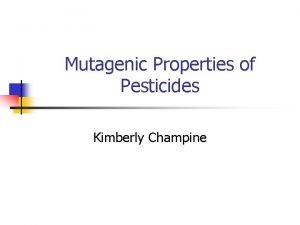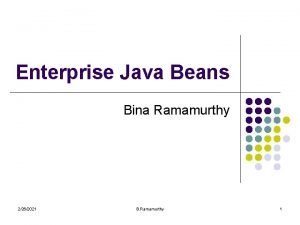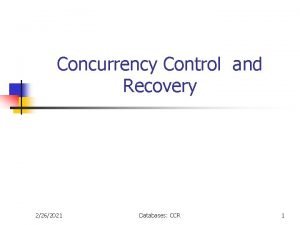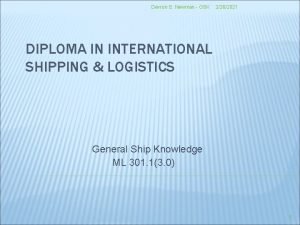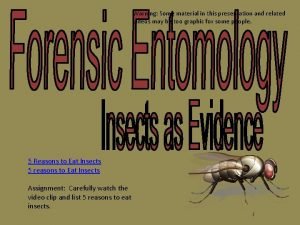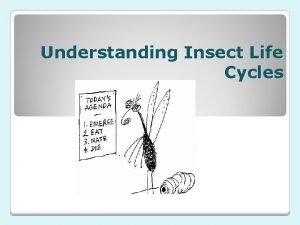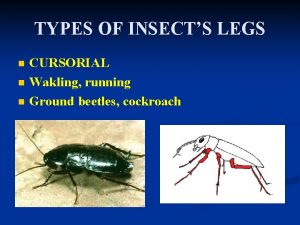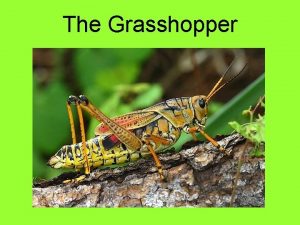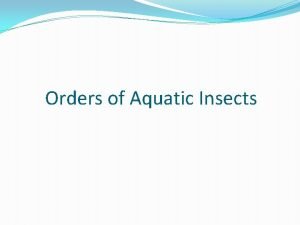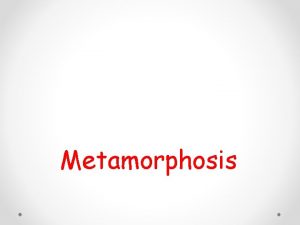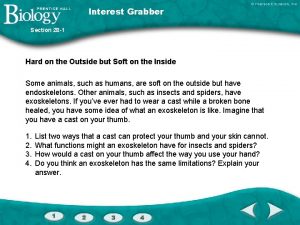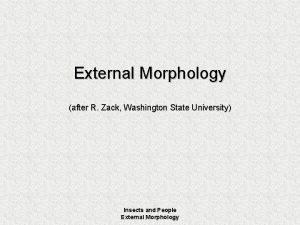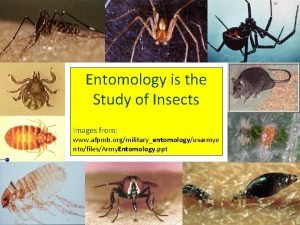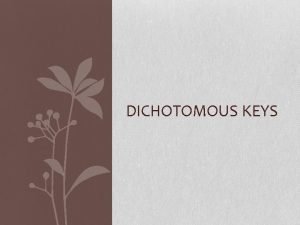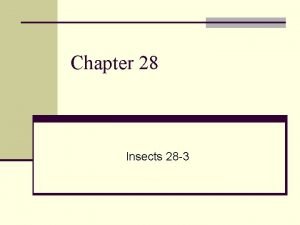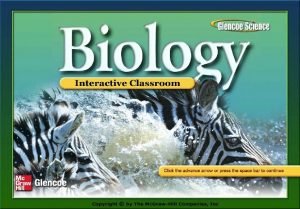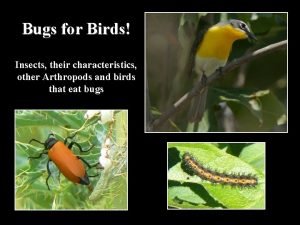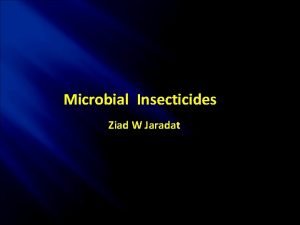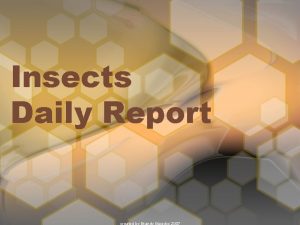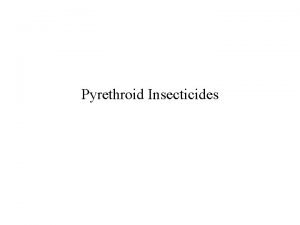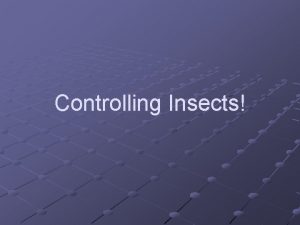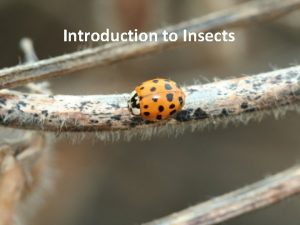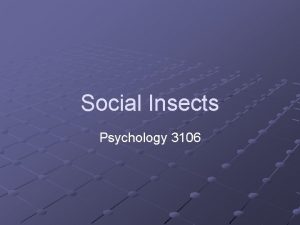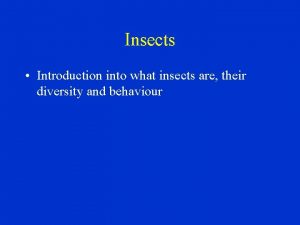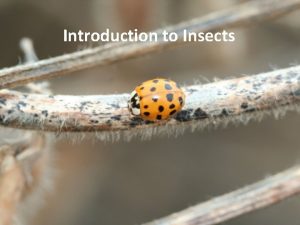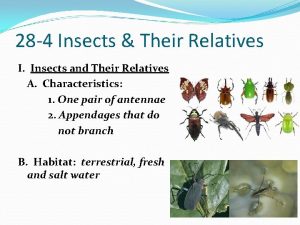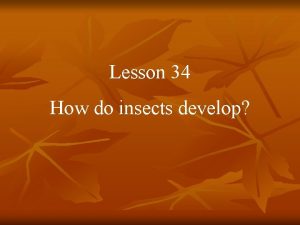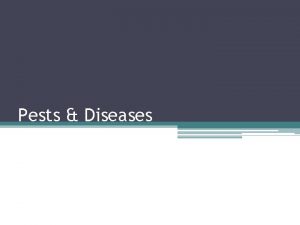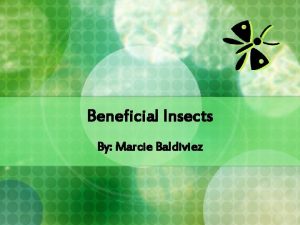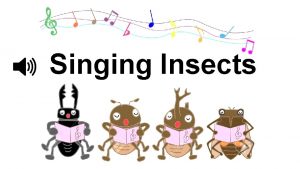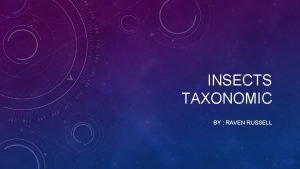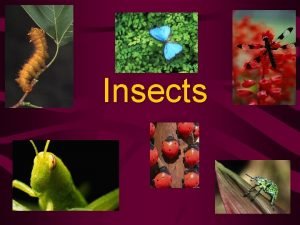Insecticides 2262021 1 Introduction Used to kill insects
























- Slides: 24

Insecticides 2/26/2021 1

Introduction • Used to kill insects. • Control of arthropod borne disease by insecticides is one of the greatest triumph of public health. 2/26/2021 2

Classification • Contact poison : pyrethrum, DDT, HCH, lindane, malathion, fenthion, methyl parathion, abate, carbaryl, propoxur, resmethrin, bioresmethrin • Stomach poison : paris green, sodium fluoride • Fumigants : hydrogen cyanide, sulphur dioxide 2/26/2021 3

Classification 1. Contact poison – kills insect by contact eg. Pyrethrum, DDT, dieldrin 2. Stomach poison – when ingested causes the death of insect eg. Paris green , sodium fluoride 3. Fumigants – gives off vapour which have lethal effect on the insects eg. Sulphur dioxide. 2/26/2021 4

Insecticides available for vector control • Group 1: – organochlorine compounds : DDT, HCH (BHC) , dieldrin, chlordane, methoxychlor. • Group 2: - organophosphorus compounds: malathion , fenthion, chlorpyrifos, abate • Group 3 : - carbamates : propoxur , carbaryl 2/26/2021 5

DDT • DDT : – Dichoro-diphenyl- tricholoroethane ü First synthesised in 1874 by German chemist, Ziedler. a) Properties : - white amorphous powder , insoluble in water but dissolves in most organic solvents. ü DDT contains 70 -80 % of para-para isomer , active fraction of DDT. 2/26/2021 6

Continued…. b) Action : Acts on nervous system of insects Permeates into body through cuticle Dissolves in waxy covering of feet Paralysis of legs and wings Convulsions Death The residual action of DDT last long as 18 months. 2/26/2021 7

Continued…. c) Application : - applies as a dosage of 100 -200 mg. per sq foot area. ü Formulation of choice is 5 per cent suspension of DDT , when sprayed at rate of 1 gallon over an area of 1000 sq. feet , gives dosage of 200 mg. Per sq ft. 2/26/2021 8

HCH • HCH (BHC) : • Benzene hexachloride / Hexa chlorocyclohexane / gammexane/ hexidol ü Synthesized in 1825 by Michael Faraday. a) Properties : - white or chocolate coloured powder with a musty smell. ü Irritates eyes , nose and skin ü Gamma isomer is most active constituent. 2/26/2021 9

HCH ü Technical HCH : – 13 – 16% of gamma isomer. ü Pure HCH : - 99% of gamma isomer called as Lindane / gamma HCH. ü HCH is slightly volatile. b) Action : - kills insects by direct contact. ü Residual action is shorter duration , upto 3 months ü Kills by vapour also. 2/26/2021 10

HCH c) Application : - dosage of 25 to 50 mg of gamma HCH per sq ft. is recommended. 2/26/2021 11

Malathion • Malathion : ü Yellow or clear brown liquid with unpleasant smell. ü Used in doses of 100 - 200 mg. oer sq ft. every 3 months. ü It is widely used for killing adult mosquitoes to prevent dengue hemorrhagic fever, and mosquito- borne encephalitis epidemics. 2/26/2021 12

Abate • Abate : - Temephos ü Brown viscous liquid , soluble in petroleum solvents. ü Extensively used in India for control of A. stephensi in wells and in domestic water containers with dosage 1. 0 ppm. 2/26/2021 13

Fenthion • Fenthion : - Baytex ü Brown liquid smells as garlic. ü Insoluble in water. ü Dosage for residual sprays is 100 mg per sq ft. ü As a larvicide it is powerful. ü Highly effective in controlling larvae of C. fatigans at rate of 1 ppm. 2/26/2021 14

Pyrethrum • Pyrethrum : ü Insecticides of vegetable origin. ü Extracted from flowers of Chrysanthemum cinerariafolium. a) Properties : - flower contains 4 active principles- Pyrethrins I and II , Cinerins I and II , all nerve poisons. ü It is an excellent space spray , ready to spray contain 0. 1 % of pyrethrins. 2/26/2021 15

Pyrethrum b) Application : - sprayed at the rate of ½ to 1 oz. Of spray solution per 1, 000 cu ft of space. ü While spraying , fine atomization is necessary and the doors and windows should kept closed for ½ hours after spraying. 2/26/2021 16

Pyrethrum and DDT • Pyrethrum and DDT: added for synergistic action. ü The standard reference aerosol recommended by WHO consist – a) Pyrethrum extract (25% pyrethrins ) , 1. 6 % b) DDT technical – 3% to be dispersed at the rate of 10 g per 1, 000 cu ft of space in the treatment of aircraft. About 1/3 rd of doses , 3. 3 g per 1, 000 cu ft used for routine treatment of dwellings. 2/26/2021 17

• Paris Green : • copper aceto-arsenite ü Emerald green microcrystalline powder , insoluble in water but soluble in ammonia and concentrated acids. ü Its an stomach poison. ü Was extensively used in control of anopheline larvae. ü Responsible for eradication of A. gambiae from Brazil in 1940. 2/26/2021 18

Insecticide Resistance • WHO definition : - “ The development of an ability in strain of insects to tolerate doses of toxicants which would prove lethal to the majority of individuals in normal population of the same species”. • Resistance is due to biochemical and genetic factors. 2/26/2021 19

Insecticide Resistance • Knowledge important –proper selection of insecticide • Organo-chlorine insecticide resistance: DDT and analogues, HCH-dieldrin group • Double resistance 2/26/2021 20

Possible ways of avoiding development of insecticide resistance in field • Avoid indiscriminate use of insecticides • Avoid use of insecticides that simultaneously select resistance to other chemically related insecticides. • Avoid use of insecticides that induce development of more than one type of resistance mechanism of broad spectrum of resistance. • Avoid use of the same insecticide both against adults and larvae. • Use of non chemical control methods, e. g. biopesticides, larvivorous fish. • Use of synergist with insecticides to reduce physiological resistance. 2/26/2021 21

Toxicity of Insecticides • Organo-chlorine compounds : ü DDT least toxic – lethal dose 250 mg/kg/body weight ü Gamma HCH is twice as toxic as DDT , where as dieldrin is 5 to 8 times toxic. ü Dieldrin poisoning is more frequently as it is absorbed through skin. ü Treatment : - Barbiturates (phenobarbitone), stomach washouts , purgatives. 2/26/2021 22

Organophosphorus compounds and Carbamates • Interfere with mechanism of transmission of nerve impulse • Cholinestrase inhibitors – accumulation of acetyl choline • Signs and symptoms – headache , giddiness , apprehensions , restlessness , cold sweating salivation , uncontrolled urination and defecation , unconsciousness , ataxia and paralysis of respiratory centre. 2/26/2021 23

Organophosphorus compounds and Carbamates • Treatment : ü Specific antidote – Atropine ü Doses 1 to 2 mg IM and repeated if necessary at 30 min interval. 2/26/2021 24
 Pesticides classification
Pesticides classification 2262021
2262021 2262021
2262021 2262021
2262021 2262021
2262021 Beakman motor
Beakman motor 2262021
2262021 2262021
2262021 Price of sport sandals drops drastically
Price of sport sandals drops drastically Anatomy of a maggot
Anatomy of a maggot Insect life cycle stages
Insect life cycle stages Platyform larvae
Platyform larvae Characteristics of insects
Characteristics of insects Conspicuous
Conspicuous Siphoning mouth parts
Siphoning mouth parts Metamorphosis in insects
Metamorphosis in insects Section 28-1 introduction to the arthropods answers
Section 28-1 introduction to the arthropods answers Animalia insects
Animalia insects Ocelli in insects
Ocelli in insects Entomology is the science that studies
Entomology is the science that studies Dichotomous key pine trees
Dichotomous key pine trees Section 28-3 insects
Section 28-3 insects Invertebrates characteristics
Invertebrates characteristics Characteristics of an insect
Characteristics of an insect Horse fertilization internal or external
Horse fertilization internal or external
